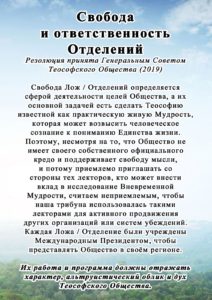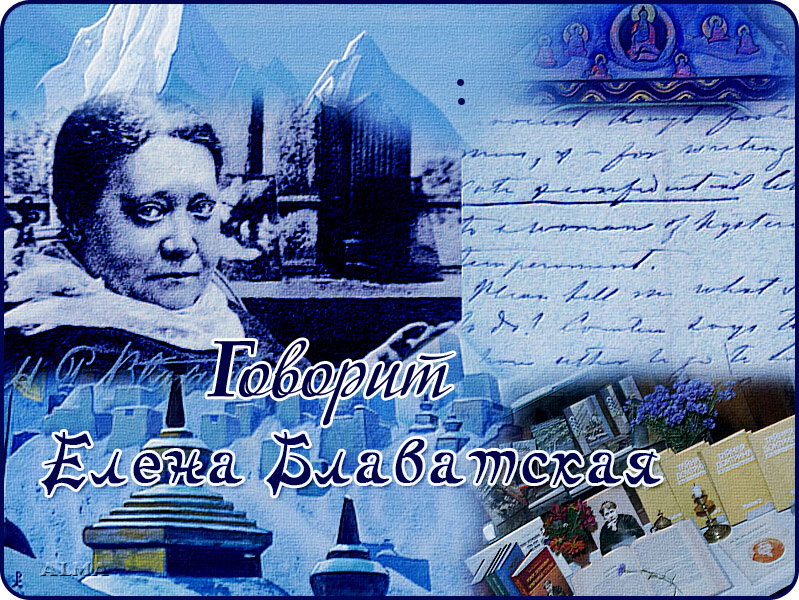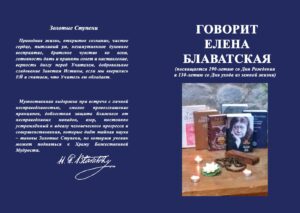
Д-р Діпа Падхі – міжнародний віце-президент ТТ “Адьяр” і президент ТОС, регіон Одіша, Індія. На основі презентації на щорічному з’їзді Новозеландської секції в січні 2020 року.
Нині ми живемо в галасливому світі, який стає дедалі гучнішим через звуки трафіку, мобільні телефони, телевізори, електронні побутові прилади тощо, що робить життя доволі неспокійним. Сьогодні шумове забруднення стало серйозною проблемою, як для фізичного, так і для психічного здоров’я людини. Шум, що перевищує норму, породжує багато захворювань, таких як гіпертонія, стрес, забудькуватість, депресія і безсоння. На додаток до зовнішнього шуму, існує ментальний шум – постійна балаканина розуму. Це свого роду внутрішній монолог, який постійно присутній у розумі. Занадто часто це негативні думки про інших, які посилюють занепокоєння, гнів, розчарування, ненависть і ревнощі.
Це прояв звички людей проводити максимум часу з будь-чим – друзями, родичами, колегами, домашніми тваринами, телевізорами, комп’ютерами чи мобільними телефонами, щоб досягти якогось щастя. Здебільшого ми намагаємося не бути наодинці з собою. Це тому, що більшість із нас не знають про те, що у внутрішній тиші є справжнє щастя і мир.
Під шумом, зовнішнім і внутрішнім, існує величезний океан тиші, де можна відчути себе розслабленим, спокійним і умиротвореним. Шум – це тільки периферія, тиша – центр, всепроникний. Усі звуки і шум виникають із тиші.
Кілька років тому я пережила незрозумілий досвід тиші. Одного чудового ранку наш сусід з правого боку вирішив знести свій старий будинок, побудувати багатоповерховий житловий комплекс і негайно приступити до роботи. У той самий час наш сусід ліворуч захотів відремонтувати свій будинок, додавши ще дві кімнати. Сім’я, що мешкає навпроти нашого будинку, почала святкувати релігійну церемонію, яка тривала десять днів, а співи лунали через гучномовець без перерви. Від шуму звідусіль я відчувала себе дуже некомфортно. Крім того, мої негативні емоції, такі як роздратування, злість і неспокій, стали дуже заважати.
Залишивши роботу незавершеною, я пішла у свою кімнату і замкнула двері. Я сіла з наміром позбутися шуму ззовні і заспокоїти свій розум. Насправді я боролася з шумом ззовні та думками всередині. Але це було марно. Шум все одно переслідував мене з усіх боків. З великою рішучістю і терпінням я продовжувала сидіти з заплющеними очима і намагалася вийти за межі шуму. Через деякий час я відчула, що зовнішній шум стихає, а внутрішні емоції заспокоюються. Я відчувала ніжний потік енергії по всьому тілу. Потім настав момент, коли не було абсолютно ніякого шуму, ні ззовні, ні зсередини. Не було ні роздратування, ні нетерпіння. Я відчула тишу з її безмежністю, яка була надзвичайно омолоджуючою і умиротвореною. Це був радісний досвід, який важко передати словами.
 Мовчання можна розділити на п’ять типів: мовчання мови, мовчання очей, вух, розуму і «я». Давайте розберемося в різних видах мовчання: Мовчання мови – Махатма Ганді говорив, і я також вважаю, що, утримуючись від мовлення, можна стати кращим слухачем. Коли ми змушені мовчати, ми змушені слухати. Більшість з нас не вміє слухати, оскільки в глибині нашої свідомості завжди щось відбувається, якісь судження або думки, що стосуються нас самих або інших. Ми майже ніколи не слухаємо повністю і не сприймаємо те, що намагається сказати інша людина. Але коли ми мовчимо, ми можемо по-справжньому слухати: ми можемо почути плач покинутого немовляти, яке лежить за зачиненими дверима будинку; ми можемо почути безпорадний крик зґвалтованого підлітка; ми можемо почути стогони голодних, які голодують багато днів поспіль.
Мовчання можна розділити на п’ять типів: мовчання мови, мовчання очей, вух, розуму і «я». Давайте розберемося в різних видах мовчання: Мовчання мови – Махатма Ганді говорив, і я також вважаю, що, утримуючись від мовлення, можна стати кращим слухачем. Коли ми змушені мовчати, ми змушені слухати. Більшість з нас не вміє слухати, оскільки в глибині нашої свідомості завжди щось відбувається, якісь судження або думки, що стосуються нас самих або інших. Ми майже ніколи не слухаємо повністю і не сприймаємо те, що намагається сказати інша людина. Але коли ми мовчимо, ми можемо по-справжньому слухати: ми можемо почути плач покинутого немовляти, яке лежить за зачиненими дверима будинку; ми можемо почути безпорадний крик зґвалтованого підлітка; ми можемо почути стогони голодних, які голодують багато днів поспіль.
Якщо ми не будемо мовчати, ми не зможемо бути кращими слухачами. Якщо ми не вміємо слухати, як ми можемо достукатися до людей, які потребують нашої допомоги? За словами святого Харидаса з Індії, ми говоримо тільки на видиху. Чим більше ми говоримо, тим більше нам доводиться видихати і тим більше життєвої енергії ми втрачаємо. Він каже: “День мовчання означає додатковий тиждень життя, а день розмови – на один тиждень життя менше. Коли ми розмовляємо, ми використовуємо величезну енергію, яку можна зберегти для медитації”. Свамі Нірмалананда, який зберігав мовчання протягом одинадцяти років, сказав: “Мудрість для мене – це не надбання слів, а свіжість і порожнеча розуму”. Махатма Ганді дотримувався мовчання щопонеділка, спілкуючись у цей день лише за допомогою записок.
В Японії люди цінують мовчання як важливу форму невербальної комунікації і вважають, що “краще багато чого не говорити”. Мовчання у мовленні передає емоції, повагу та особисту дистанцію. У мовчанні ми можемо знайти те, що шукаємо – чи то загублений ключ від машини, чи складну математичну задачу.
Мовчання очей – наші фізичні очі є головними дверима у зовнішній світ. Іноді у зовнішньому світі є тривожні види, яких можна уникнути, якщо заплющити фізичні очі. Але можна відкрити їх на красу і добро навколо нас. Закривати фізичні очі може означати залишатися в тиші з заплющеними очима. З іншого боку, деякі буддисти вірять, що сидячи в тиші з розплющеними очима, людина не відчуває тупості чи сонливості, і що зір “сам по собі стає більш об’ємним, в погляді більше спокою і співчуття”. Тримаючи очі відкритими, ми можемо бачити, з практикою, все з його неосяжністю і красою природи навколо, відчуваючи “теперішнє”, будучи повністю пробудженими. Береги річок і струмків, сади з квітами і листям, вершини пагорбів – одні з найкращих місць, де можна практикувати мовчання з розплющеними очима.
Зазвичай, коли ми сидимо в тиші, очі автоматично заплющуються. Ми можемо уявити подумки красу природи: сонце, що сходить над горизонтом, повний місяць, чудовий вид водоспаду тощо, і зануритися в будь-яку з цих картин. Ці бачення заспокоюють і гармонують з нашим внутрішнім “Я”. Можна сидіти із заплющеними як фізичними, так і ментальними очима, щоб перебувати в глибокій тиші, де вже немає жодних образів – ні фізичних, ні ментальних. Це те, що насправді мається на увазі під “мовчанням очей”.
 Тиша вух – тишу вух можна спостерігати, тримаючись подалі від зовнішнього шуму. Звук – це віддзеркалення енергії, а шум – це небажана, непотрібна енергія. Потрібно намагатися уникати шуму, наскільки це можливо. Природа створює звук, а не шум. Рано вранці на прогулянці можна почути щебет птахів, подув вітру. Стоячи на пляжі, можна почути, як хвилі розбиваються об берег. Звуки природи дуже заспокоюють, оскільки вони співзвучні з нашим внутрішнім світом і тому допомагають нам глибше зануритися в тишу. Це нагадує мені Махатму Ганді, який мав звичку тримати на своєму столі ідола з трьома мавпами: одна закривала очі, інша – вуха, а третя – рот. Це символізує мовчання очей, вух і мови. Однак всі ці три способи засновані на замовчуванні думок у розумі. Зовнішня тиша – це лише засіб, який допомагає нам віднайти внутрішню тишу.
Тиша вух – тишу вух можна спостерігати, тримаючись подалі від зовнішнього шуму. Звук – це віддзеркалення енергії, а шум – це небажана, непотрібна енергія. Потрібно намагатися уникати шуму, наскільки це можливо. Природа створює звук, а не шум. Рано вранці на прогулянці можна почути щебет птахів, подув вітру. Стоячи на пляжі, можна почути, як хвилі розбиваються об берег. Звуки природи дуже заспокоюють, оскільки вони співзвучні з нашим внутрішнім світом і тому допомагають нам глибше зануритися в тишу. Це нагадує мені Махатму Ганді, який мав звичку тримати на своєму столі ідола з трьома мавпами: одна закривала очі, інша – вуха, а третя – рот. Це символізує мовчання очей, вух і мови. Однак всі ці три способи засновані на замовчуванні думок у розумі. Зовнішня тиша – це лише засіб, який допомагає нам віднайти внутрішню тишу.
Тиша розуму – Як їжа необхідна для фізичного тіла, так і тиша потрібна для живлення розуму. Розум є джерелом будь-якого шуму, будь-якої турбулентності. Мадам О. П. Блаватська (ОПБ) описує розум як “вбивцю Реального”. Розум спотворює факти своїми проекціями, які мають коріння в несвідомих мотивах або бажаннях. Тому вона каже “вбий вбивцю”. Всі голоси розуму повинні замовкнути, щоб той, хто шукає, міг почути внутрішній голос. І коли людина приходить до такого стану, вона може з’єднатися з усіма.
Хоча тиша здається пасивною, вона динамічна, тому що вона потужна. З тиші народжується все добре. Дж. Крішнамурті говорить про динамічну тишу розуму, яка знаходиться на рівні психодуховного досвіду. Для нього “активний розум мовчазний, усвідомлений і безвибірковий”. Крішнамурті каже: “Існує тиша розуму, якої ніколи не торкнеться жоден шум, жодна думка, жоден вітер досвіду. Ця тиша невинна і тому нескінченна. Коли є ця тиша розуму, з неї випливає дія, і ця дія не спричиняє жодного сум’яття чи страждання”.
Заглушити розум означає стати свідком думок, які проносяться в голові, і спробувати з’ясувати джерело цих думок. Саме тут мовчання стає медитацією. Можна також сказати, що тиша – це єдиний стан існування, в якому даються відповіді на всі питання, малі чи великі, розвіюються всі сумніви, знаходяться всі творчі рішення, приймаються всі рішення. Мій особистий досвід свідчить, що в тиші можна відпустити свій болючий досвід минулого і вивільнити пригнічені емоції. Вона дає сили боротися зі складними життєвими викликами, а також показує вихід з них. Це місце, де можна пробачити тих, хто завдав тобі найбільше болю. Вона допомагає контролювати такі емоції, як гнів, жадібність, занепокоєння, стрес тощо, і наповнює серце рясною радістю. Наукові дослідження показують, що щоденне перебування в тиші принаймні дві години збільшує вироблення клітин мозку, які знижують ризик деменції та безсоння. Кажуть, що тиша зміцнює гіпокамп – частину мозку, що відповідає за короткочасну і довготривалу пам’ять.
Мовчання “я” – Більшість основних релігій світу розглядають тишу як місце, де можна пізнати Абсолютну Реальність, Істину. Слово “мауна” на санскриті означає “тиша” і походить від слова “муні“, що означає просвітленого, який інтенсивно мовчить, спокійний і пробуджений. Будда вважається великим “муні“. Буддисти вірять, що просвітлення можна досягти лише через тишу, а вчення можна зрозуміти за допомогою мовчазної медитації та споглядання.
Господь Крішна говорить у “Бхаґавадгіті” (Х.38): “З усього таємного Я є Тиша”. Пізнання самого себе описується в індійських писаннях як “таємниця всіх таємниць”, яку можна пізнати лише в глибокій внутрішній тиші. В індуїстській філософії, включаючи вчення Адвайта Веданти і численні шляхи йоги, мовчанню надається велике значення для цілісного духовного зростання і трансформації. У джайнізмі мова вважається великою, але мовчання – ще більшим. “Мовчання – це святий храм наших божественних думок”. Господь Махавіра дотримувався мовчання протягом дванадцяти з половиною років, перш ніж став кеваліном (просвітленим).
Єврейські мудреці стверджують, що “захисна огорожа для мудрості – це мовчання”. У християнстві сказано: “Лише Бога чекає душа моя в тиші”. (Псалми 62:1) “Спокійно, і пізнай, що Я – Бог” (Псалми 46:10). (Пс. 46:10) Мати Тереза каже: “Нам потрібно знайти Бога, а Його не можна знайти в шумі і неспокої. Бог – друг тиші. Подивіться, як природа – дерева, квіти, трава – ростуть у тиші. Подивіться на зорі, місяць, сонце – як вони рухаються в тиші. Нам потрібна тиша, щоб мати змогу доторкнутися до душ”.
Суфійський святий Румі вчить: “Мовчання – це мова Бога, все інше – поганий переклад“. Мовчання в ісламі – це просто Спасіння. Для них мудрість полягає в тому, щоб мовчати, і тих, хто це практикує, небагато. Релігія Бахаї вважає, що “ознакою розуму є споглядання, а ознакою споглядання є мовчання, бо неможливо людині робити дві речі одночасно – вона не може одночасно говорити і медитувати”.
Для більш щирих духовних шукачів практика медитації необхідна для того, щоб заглиблюватися в тишу глибше і на довший період. “Чим глибше занурюєшся в тишу, тим ближче стаєш до Всесвіту. У тиші немає “іншого”. Тиша – це єдність, всепроникна. Під гучним і галасливим світом є тиша і спокій, які можна безпосередньо відчути. Всі техніки медитації призначені для того, щоб привести нас до найглибшого стану внутрішньої тиші. За словами ОПБ: “Той, хто хоче почути голос нада, “беззвучного Звуку”, і осягнути його, повинен пізнати природу дхарани, або здатність непохитно зосереджуватися”.
Звук і тиша не є двома протилежними поняттями. Кажуть, що і звук, і тиша представляють дві форми звуку: чутний, який є звуком Відомого, і тиша, яка представляє нечутний звук, який є звуком Невідомого. Коли ми медитуємо, намагаючись зануритися в тишу, ми намагаємося слухати унікальний звук – вібруючий звук Всесвіту, який є звуком нашої внутрішньої душі. Це те, що ОПБ називає nâda, беззвучний, нечутний звук. Це голос всередині кожного з нас і в усьому космосі, який є прихованим і тонким. Наша мета на Землі – “возз’єднатися з цим Голосом, який є голосом нашого внутрішнього “Я”, – каже ОПБ. Це голос тиші. Для голосу тиші не потрібні вуха.
У “Насадія-сукта” Рігведи згадується, що до створення Всесвіту не існувало ні часу, ні простору, ні буття, ні небуття. Була повна тиша, чиста свідомість, або Абсолютна Свідомість, яка у ведантичній термінології називається Нірґуна Брахман. Ця чиста Свідомість проявилася як Вселенська Свідомість, або Сагуна Брахман, разом з резонуючою вібраційною надою, звуком “Ом”. Це первісний звук макро- і мікросвіту.
У цьому контексті я хотіла би згадати досвід Ебена Александера, американського невропатолога. Він розповідав в інтерв’ю про свій передсмертний досвід, що коли його клінічно оголосили мертвим і він опинився поза тілом, то почув незвичний звук – “Ом”. Раніше він не мав жодного уявлення ні про це слово, ні про звук. Цей звук можна почути, коли немає тіла-свідомості, а є лише свідомість.
Тиша – це усвідомлення. В “Мундака Упанішаді” згадується, що “Тиша – це Атман (Я)”. Насправді, мовчання – це справжнє вчення про найвищу Реальність, тому що Абсолют знаходиться поза межами мови і думки. Рамана Махарші навчав своїх послідовників через мовчання. Для нього мовчання в абсолютному сенсі є кульмінацією джняни – самореалізації.
В одній з Упанішад учень звертається до вчителя: “Учителю, розкажи мені про природу Я, або Атмана”. Учитель промовчав. Знову було поставлено питання, і знову відповіддю було мовчання. Своїм мовчанням вчитель вказував, що оскільки природа Я, або Атмана, невимовна в словах, то Я є Тиша. Вона безпосередньо відчувається через свідомість. Мовчання – це і подорож, і пункт призначення.
Сьогодні життя стало більш хаотичним і гучним, тому що ми втратили мистецтво мовчання, яке є таким важливим і потужним для нашого мирного існування. Якби дітей старше шести років можна було навчити медитувати або перебувати в тиші протягом двадцяти хвилин щодня, вони б перетворилися на високорозвинених і процвітаючих людей. Тиша має неймовірну силу. Зараз люди готові платити великі гроші, щоб поїхати в ретритні центри за радісним досвідом тиші. Насправді це не потрібно, оскільки тиша завжди є всередині нас. Що нам насправді потрібно, так це простий, цілісний спосіб життя, який вимагає здорової їжі для тіла, розумової тиші для роздумів і глибшої тиші (медитації) для перетворення себе. Збагачуймо і перетворюймо наше життя, збільшуючи роль тиші в нашому повсякденному існуванні.
ОПБ сказала, що не існує таких речей, як “твій розум” і “мій розум”; є тільки розум. Серйозно ставитися до людських сердець, а також до свого власного серця означає бачити ілюзії, в які людину вводить давня звичка описувати, називати і робити висновки про природу себе та інших людей.
Радха Берньє, Шлях самопізнання, с. 11
The Incredible Power of Silence, Deepa Padhi
Dr Deepa Padhi is international Vice-President of the Adyar TS and President of the TOS, Odisha Region, India. Based on a presentation to the annual Convention of the New Zealand Section in January 2020.
AT present we are living in a loud world which is becoming increasingly noisy with the sounds of traffic, cell phones, TVs, electronic home appliances, and so on, making life quite uneasy. Today, noise pollution has become a serious problem for both physical and mental human health. Noise beyond a limit produces many diseases such as hypertension, stress, forgetfulness, depression, and insomnia. In addition to the outward noise, there is mental noise — the constant chatter of the mind. It is a kind of inner monologue that goes on constantly in the mind. Too often these are negative thoughts about others that intensify worries, anger, frustration, hatred, and jealousy.
This is a manifestation of the habit of human beings spending maximum time with anything — friends, relatives, colleagues, pets, TVs, computers, or mobile phones to achieve some kind of happiness. We mostly try to avoid being with ourselves. That is because most of us are ignorant of the fact that there is true happiness and peace in the silence within.
Beneath the noise, outer and inner, there is a vast ocean of silence where one can feel relaxed, calm, and peaceful. Noise is only the periphery, silence is the centre, all-pervading. All sounds and noise arise from silence.
Some years ago I had an inexplicable experience of silence. One fine morning our next door neighbour on the right side decided to demolish their old house, build a multistory apartment complex, and start the work without delay. During the same time, our left-side neighbor felt like renovating his house by adding two more rooms. The family living opposite our house started celebrating a religious function lasting ten days, with chanting played through a loudspeaker without any break. With noise from all around I felt very uncomfortable. In addition, my negative emotions like irritation, anger, and restlessness became quite bothersome.
Leaving my work unfinished, I went into my room and locked the door. I sat down with the intention of getting rid of the noise outside and quietening the mind. I was, in fact, fighting the noise outside and the thoughts within. But it was of no use. The noise still haunted me from all sides. With much determination and patience, I continued to sit there with my eyes closed and tried to go beyond the noise. After some time I felt the outside noise fading away and inner emotions calming down. I could feel a gentle flow of energy throughout my body. Then a moment came when there was absolutely no noise, either from outside or inside. There was no irritation, no impatience. I experienced silence with its vastness, which was extremely rejuvenating and peaceful. It was a joyful experience, diffiicult to express in words.
Silence can be categorized into five types: of speech, of the eyes, ears, mind, and Self. Let us understand the different modes of silence: Silence of Speech – Mahatma Gandhi used to say, and I also believe, that by abstaining from speaking one can become a better listener. When we are forced to be silent, we are forced to listen. Most of us do not know how to listen, as there is always something going on in the back of our mind, some judgment or thoughts relating to ourselves or to others. We almost never fully listen and take in what another person is trying to say. But when we remain in silence, we can really listen: we can hear the cry of an abandoned baby lying outside the closed door of a home; we can hear the helpless cry of a molested teenager; we can hear the groans of the hungry for days on end.
 Unless we are in silence, we cannot be a better listener. Unless we are a better listener, how can we reach out to people who need our help? According to Saint Haridas of India, we talk only by exhalation. The more we talk, the more we have to exhale and the more life energy we lose. He says: “A day’s silence means an additional week of life, and a day’s speech means one fewer week of life. When we talk we use tremendous energy, which can be preserved for meditation.” Swami Nirmalananda, who remained in silence for eleven years, said: “Wisdom to me is not an asset of words, but freshness and emptiness of mind.” Mahatma Gandhi used to observe silence every Monday, communicating on that day only through writing notes.
Unless we are in silence, we cannot be a better listener. Unless we are a better listener, how can we reach out to people who need our help? According to Saint Haridas of India, we talk only by exhalation. The more we talk, the more we have to exhale and the more life energy we lose. He says: “A day’s silence means an additional week of life, and a day’s speech means one fewer week of life. When we talk we use tremendous energy, which can be preserved for meditation.” Swami Nirmalananda, who remained in silence for eleven years, said: “Wisdom to me is not an asset of words, but freshness and emptiness of mind.” Mahatma Gandhi used to observe silence every Monday, communicating on that day only through writing notes.
In Japan people value silence as an essential form of non-verbal communication and believe that “it is better to keep many things unsaid”. Silence in speech conveys emotions, respect, and personal distance. In silence of speech we can find what we are looking for — whether it is a misplaced car key or a challenging mathematical problem.
Silence of the eyes – Our physical eyes are the main doors to the outer world. There are sometimes disturbing sights in the outer world which are avoidable by silencing the physical eyes. But one can open them to the beauty and goodness around us. Silencing the physical eyes may mean remaining in silence with eyes closed. On the other hand, some Buddhists believe in sitting in silence with eyes open so that one would not feel dull or sleepy, and that the vision “itself becomes more expansive, there being more peace and compassion in one’s gaze”. By keeping the eyes open, we can see, with practice, everything with its vastness and the beauty of Nature all around, experiencing the “present”, being fully awake. The banks of rivers and streams, gardens with flowers and fo-liage, and hilltops are some of the best places where one can practise silence with eyes open.
Usually when we sit in silence, automatically the eyes get closed. We can visualize with our mental eyes Nature’s beauty like the rising sun over the horizon, the full moon, the lovely sight of the waterfall, and so on, and get absorbed in any of them. Those visions are soothing and in harmony with our inner self. One can be seated with both physical and mental eyes closed to be in deeper silence, where there are no longer any images — physical or mental. This is what is really meant by “silence of the eyes”.
 Silence of the ears – Silence of the ears can be observed by keeping away from outer noise. Sound is reverberation of energy and noise is unwanted, undesirable energy. One should try to avoid noise as much as one can. Nature makes sound, not noise. Early in the morning one can hear the birds chirp, the wind blowing when taking a stroll. Standing on the beach one can hear the waves crashing on the shore.The sounds of Nature are very soothing, as they are in tune with our inner peace and therefore help us to transcend more deeply into the silence. It reminds me of Mahatma Gandhi, who used to keep an idol of three monkeys on his table — one covering the eyes, another covering the ears, and the third covering the mouth. This depicts silencing the eyes, ears, and speech. However, all these three are based on silencing thoughts in the mind. Outer silence is simply a means to help us find the inner silence.
Silence of the ears – Silence of the ears can be observed by keeping away from outer noise. Sound is reverberation of energy and noise is unwanted, undesirable energy. One should try to avoid noise as much as one can. Nature makes sound, not noise. Early in the morning one can hear the birds chirp, the wind blowing when taking a stroll. Standing on the beach one can hear the waves crashing on the shore.The sounds of Nature are very soothing, as they are in tune with our inner peace and therefore help us to transcend more deeply into the silence. It reminds me of Mahatma Gandhi, who used to keep an idol of three monkeys on his table — one covering the eyes, another covering the ears, and the third covering the mouth. This depicts silencing the eyes, ears, and speech. However, all these three are based on silencing thoughts in the mind. Outer silence is simply a means to help us find the inner silence.
Silence of the mind – As food is required for the physical body, silence is needed for the nourishment of the mind. Mind is the source of all noise, all turbulence. Madame H. P. Blavatsky (HPB) describes the mind as the “slayer of the Real”. The mind distorts facts by its projections, which have their roots in unconscious motives or desires. Therefore, she says “slay the slayer”. All the voices of the mind must be silenced so that the seeker can hear the inner voice. And when one comes to experience such a state, one can be united with all.
Though it appears to be passive, silence is dynamic because it is powerful. Everything good comes out of silence. J. Krishnamurti speaks of the dynamic silence of the mind, which is at the level of psychospiritual experience. To him, “an active mind is silent, aware, and choiceless.” Krishnamurti says: “There is the silence of the mind which is never touched by any noise, by any thought, or by the passing wind of experience. It is the silence that is innocent and therefore endless. When there is this silence of the mind, action springs from it, and this action does not cause any confusion or misery.”
Silencing the mind means becoming witness of the thoughts that go through our mind, and trying to find out the source of these thoughts. This is where silence becomes meditation. Silence can also be said to be a unified state of existence where all questions, minor or major, are answered, all doubts are dissolved, all creative solutions are found, all decisions are made. It is my personal experience that, in silence, one can let go one’s painful experiences of the past and release repressed emotions. It gives strength to deal with difficult challenges in life and shows the way out of them as well. It is the place where you can forgive those who hurt you the most. It helps to control emotions such as anger, greed, worry, stress, and so forth, and fills the heart with abundant joy. Scientific researches show that experiencing at least two hours of silence every day increases the production of brain cells, which reduce the risk of dementia and insomnia. They say that silence strengthens the hippocampus, a part of the brain responsible for short- and long-term memory.
Silence of the Self – Most of the major religions of the world consider silence as a place to experience the Ultimate Reality, Truth. The word mauna in Sanskrit means “silence” and is derived from the word “muni”, whicht refers to the enlightened one who is intensely silent, calm, and awakened. The Buddha is considered a great “muni”. Buddhists believe that enlightenment can be achieved only through silence, and teachings can be understood with silent meditation and contemplation.
Lord Krishna says in the Bhagavaditâ (X.38): “Of all things secret, I am Silence.” The knowledge of the Self is described in Indian scriptures as “the secret of all secrets”, which is experienced only in the deep inner silence. In Hindu philosophy, including the teach-ings of Advaita Vedânta and the many paths of Yoga, silence is given much importance for integral spiritual growth and transformation. In Jainism speech is considered great but silence is greater still. “Silence is the holy temple of our divine thoughts.” Lord Mahavira observed silence for twelveand-a-half years before he became a kevalin (enlightened).
The Jewish sages claim that “a safety fence for wisdom is silence”. In Christianity it is said: “For God alone my soul waits in silence.” (Psalms 62:1) “Be still, and know that I am God.” (Psalms 46:10) Mother Theresa says: “We need to find God, and He cannot be found in noise and restlessness. God is the friend of silence. See how Nature — trees, flowers, grass — grow in silence. See the stars, the moon, and the sun — how they move in silence. We need silence to be able to touch souls.”
The Sufi saint Rumi teaches: “Silence is the language of God, all else is poor translation.” Silence in Islam is simply Salvation. For them, wisdom consists in keeping silent, and those who practise it are few. The Baha’i religion believes that “the sign of the intellect is contemplation and the sign of contemplation is silence, because it is impossible for a man to do two things at a time — he cannot both speak and meditate.”
For more sincere spiritual seekers, practice of meditation is necessary to go deeper into silence and for a longer period. “The deeper one goes into silence, the closer one becomes part of the All. There is no “other” in silence. Silence is oneness, all pervasive. Beneath the loud and noisy world, there is stillness and peace that can be directly experienced. All the techniques of meditation are meant to bring us to the deepest state of inner silence. In the words of HPB: “He who would hear the voice of nâda, ‘the soundless Sound’, and comprehend it, has to learn the nature of dhâranâ, or the ability to focus steadfastly.’’
 Sound and silence are not two opposite concepts. It is said that both sound and silence represent two forms of sound: audible, which is sound of the Known, and silence that represents non-audible sound, which is sound of the Unknown. When we meditate trying to immerse ourselves in silence, we try to listen to a unique sound — the vibrating sound of the Universe, which is that of our inner soul. It is that which HPB refers to as nâda, the soundless, non-audible sound. This is a voice inside all of us and out in the whole cosmos that is hidden and subtle. Our purpose on Earth is “to reconnect ourselves with that Voice — which is the voice of our inner self”, says HPB. That is the voice of the silence. No ears are required for the voice of the silence.
Sound and silence are not two opposite concepts. It is said that both sound and silence represent two forms of sound: audible, which is sound of the Known, and silence that represents non-audible sound, which is sound of the Unknown. When we meditate trying to immerse ourselves in silence, we try to listen to a unique sound — the vibrating sound of the Universe, which is that of our inner soul. It is that which HPB refers to as nâda, the soundless, non-audible sound. This is a voice inside all of us and out in the whole cosmos that is hidden and subtle. Our purpose on Earth is “to reconnect ourselves with that Voice — which is the voice of our inner self”, says HPB. That is the voice of the silence. No ears are required for the voice of the silence.
In the Nâsadiya Sukta of the RigVeda, it is mentioned that before creation of the Universe, there was no time, no space, no being, no non-being. There was total silence, pure consciousness, or Absolute Consciousness, which is called Nirguna Brahman in Vedantic terminology. This Pure Consciousness was manifested as Universal Consciousness, or Saguna Brahman, along with the resonating vibrational nâda, the sound of “Om”. It is the primordial sound of the macrocosm and the microcosm.
In this context I would like to mention the experience of Eben Alexander, an American neurologist. He narrated in an interview about his near-death experience that when he was clinically declared dead and was out of the body, he heard an unusual sound — “Om”. Earlier, he had no idea of either this word or the sound. This sound can be heard when there is no body-consciousness but only consciousness.
Silence is awareness. The Mundaka Upanishad mentions that “Silence is Atman (the Self)”. In fact, silence is the genuine teaching about the ultimate Reality because the Absolute is beyond the scope of speech and thought. Ramana Maharshi used to teach his followers through silence. To him, silence in the absolute sense is the culmination of jñâna — self-realization.
In one of the Upanishads, the disciple says to the teacher, “Master, tell me the nature of the Self, or Atman.” The teacher remained silent. Again the question was asked and again the answer was silence. By his silence, the teacher indicated that as the nature of Self, or Atman, is indescribable in words, Self is Silence. It is directly experienced through consciousness. Silence is both a journey and the destination.
Today life has become more chaotic and loud because we have lost the art of being silent, which is so essential and powerful for our peaceful existence. If children over six years of age could be taught to meditate or remain in silence for twenty minutes every day, they would be transformed into highly developed and flourishing human beings. Silence has incredible power. Now people are prepared to pay heavily to go to retreat centres for the joyful experience of silence. In fact, this is not needed, as silence is ever within us. What we really need is a simple, holistic lifestyle that requires healthy food for the body, mental silence for reflection, and deeper silence (meditation) for the transformation of the self. Let us enrich and transform our life by increasing the role of silence in our day-to-day existence.
HPB said that there is no such thing as “your mind” and “my mind”; there is only mind. To regard earnestly the hearts of men and also one’s own heart is to see the illusions into which one is led by the long-existing habit of describing, naming, and drawing conclusions upon the nature of oneself and of others.
Radha Burnier The Way of Self-knowledge, p. 11
 Рубрики
Рубрики  Метки:
Метки: 













